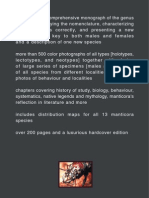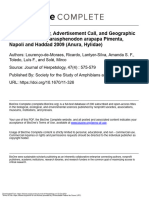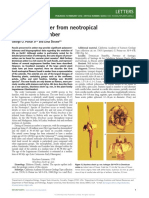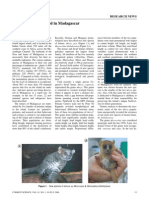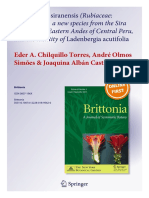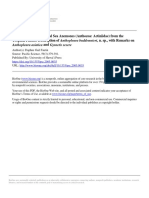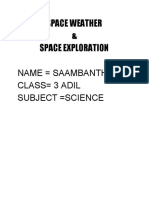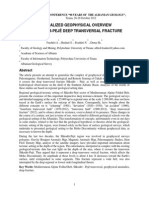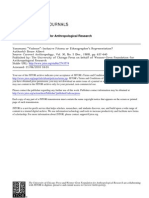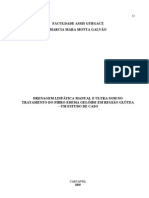Amphisbaena Arda
Amphisbaena Arda
Uploaded by
jonho2006Copyright:
Available Formats
Amphisbaena Arda
Amphisbaena Arda
Uploaded by
jonho2006Copyright
Available Formats
Share this document
Did you find this document useful?
Is this content inappropriate?
Copyright:
Available Formats
Amphisbaena Arda
Amphisbaena Arda
Uploaded by
jonho2006Copyright:
Available Formats
Phyllomedusa 1(2):51-56, 2002
2002 Melopsittacus Publicaes Cientficas
ISSN 1519-1397
Herpetofauna of the Quaternary sand dunes of the
Middle Rio So Francisco, Bahia, Brazil. VIII.
Amphisbaena arda sp. nov., a fuliginosa-like
checkered patterned Amphisbaena (Squamata,
Amphisbaenidae)
Miguel Trefaut Rodrigues
Departamento de Zoologia, Instituto de Biocincias, Universidade de So Paulo, Caixa Postal 11.461, CEP 05422-970,
So Paulo, SP, Brazil. E-mail: mturodri@usp.br.
Abstract
Herpetofauna of the Quaternary sand dunes of the Middle Rio So Francisco,
Bahia, Brazil. VIII. Amphisbaena arda sp. nov., a fuliginosa-like checkered
patterned Amphisbaena (Squamata, Amphisbaenidae). Amphisbaena arda sp. nov.
is described based on a specimen obtained at Mocambo do Vento, on the left bank of
the So Francisco river, Bahia State, Brazil. A. arda is a medium sized amphisbaenian
with a checkered black and white color pattern similar to the one present in the fuli-
ginosa group but differing from that by having a lighter pigmentation, an uniformly
white ventral surface, and by several other important morphological characters. A. arda
is similar to Amphisbaena vermicularis in meristic characters currently used to assist
amphisbaenian identification but can be separated from it by its color pattern, its flatter
cephalic shields, and by the more ventral position of nostril.
Keywords: Amphisbaena arda, Amphisbaenidae, Squamata, Caatingas, Brazil.
Introduction South America. Four new genera and a total of
21 new species of squamates, most endemic,
The squamate fauna of the fossil dunes of were described from the region (Rodrigues
the middle Rio So Francisco in the Brazilian 1984a, b, c, 1986, 1991a, b, c, d, 1993a, b,
semiarid Caatingas, State of Bahia, is 1996, Rodrigues and Junc 2002, Rodrigues et
characterized by high richness and endemism. al. 1988, Vanzolini 1991a, b). It has been
An important part of squamates from the area suggested that some of the endemic squamates
was described in the last few years, including form allopatric pairs of sister species occupying
new genera, some showing unsuspected adjacent and opposite sand habitats along the
morphological adaptations for life on sand in river (Rodrigues 1996, Rodrigues and Junc
2002). Although additional surveys in the area
Received 19 November 2002 are still revealing the existence of undescribed
Accepted 29 December 2002 lizards, snakes, amphisbaenians, and frogs, and
Phyllomedusa - 1(2), December 2002
51
Rodrigues
confirming the uniqueness of this region, most and parietals, 242 body and 30 caudal annuli,
of the invertebrate fauna remains largely 23 dorsal and 23 ventral segments per annuli at
unexplored (see Rodrigues 1996 and Rodrigues midbody, 4 precloacal pores, 4 supralabials, and
and Junc 2002, respectively, for a detailed 3 infralabials. The distance between nostril and
description of the area and a list of references upper lip equals distance from nostril to suture
on the fauna). between nasals. Additionally the new species
Six species of amphisbaenians are known to differs from all other Amphisbaena by
occur in the dunes of middle Rio So Francis- presenting a checkered black and white pattern
co; three of them are endemics: Amphisbaena which is restricted to dorsal and lateral parts of
frontalis, A. hastata, and A. ignatiana (Rodri- body; the ventral surface is immaculate creamy
gues 1996, Vanzolini 1991a, b). The other three white.
species are A. pretrei, A. vermicularis, and
Leposternon polystegum. Description of the holotype - (Figures 1 and
In a recent trip to the region, an unusual 2). A medium-sized amphisbaenid with an
medium-sized Amphisbaena with a characte- elongate snout, a total length of 330 mm (285
ristic checkered black and white pattern, + 45) and 9 mm diameter at midbody. Head not
reminding that present in the fuliginosa group distinct from neck, mouth ventral. Rostral
of Amphisbaena, was obtained in the dunes of scarcely visible from above, subtriangular,
the left bank of the Rio So Francisco. However, contacting first supralabial, and nasal, their
after a more careful examination, this unique larger contact with the latter. Nasals, frontals
specimen revealed to be unrelated to the fuligi- and parietals in broad contact at midline. Nasal
nosa group. Although keyed out and apparently large, quadrangular, in broad contact with first
close to A. vermicularis the specimen is so supralabial and frontal. Nostril lateral, in the
distinct from that species and all other anteroventral part of nasal. Frontal larger than
congeners that it is herein described as a new nasal, longer than wide, shorter at midline
species. suture, longer at labial border; suture between
frontals about the same size of suture between
Species Description nasals and parietal suture. Parietals
subtriangular, longer than wide, following
Amphisbaena arda sp. nov. frontals and in slight contact with ocular. A pair
(Figures 1 and 2) of enlarged occipitals in contact at midline
followed posteriorly by smaller scales towards
Holotype - MZUSP 91638, Mocambo do the first body annulus. Four supralabials in the
Vento (104913S, 425226W), Ibiraba: following order of decreasing size of their base:
State of Bahia: Brazil, collected by M. T. first, second, third and fourth. The first three
Rodrigues, F. Curcio, F. F. Oliveira, J. C. diagonally oriented. First supralabial below na-
Passoni, and M. Dixo on 16 May 2000; field sal, in slight contact with frontal. Second and
number MRT 3642. third supralabials higher than long, second one
contacting prefrontal and ocular, third one
Etymology - from the Greek arda, dirty; contacting the ocular and temporal. Ocular
a reference to the unclean color pattern of the quadrangular, with the eye in the dorsoposterior
new species, predominantly milky-white with part of scale. Between occipital and the fourth
irregular and scattered black spots. supralabial level, two longitudinal rows of
temporals decreasing gradually in size ventrally;
Diagnosis - A medium-sized Amphisbaena anterior scale of the dorsal row larger,
with an elongate snout, paired nasals, frontals contacting ocular.
Phyllomedusa - 1(2), December 2002
52
Amphisbaena arda sp. nov.
Mental smaller than rostral, as long as
wide, wider anteriorly, their lateral margins
concave and converging posteriorly to a large
and truncate posterior margin. Postmental
single, longer than wide, about twice as long as
mental; its posterior part triangular indenting
deeply two symmetric and slightly enlarged chin
shields (postgenials) in contact at midline.
Between the latter and infralabials a much larger
malar which additionally contacts second and
third infralabials, and postmental. Malar
contacting posteriorly a slightly enlarged scale,
the only differentiated in the annulus and in
contact with third infralabial. Three infralabials,
second the largest; first as long as wide, third
longer than wide.
Body annuli well marked with regular and
conspicuous segments separated by lateral
grooves. Segments of first three annuli as long
as wide, from there on becoming gradually
longer than wide; 242 body and 30 caudal
annuli; 23 dorsal and 23 ventral segments per
Figure 1 - Amphisbaena arda: ventral, lateral, and dorsal
views of head (MZUSP 91638, holotype).
Bar = 1 mm.
Figure 3 - Regression of head width on body length for
the specimens of Amphisbaena vermicularis
Figure 2 - Amphisbaena arda: color in life of the holotype from Santo Incio and Vacaria, State of Bahia,
(MZUSP 91638) from Mocambo do Vento, Brazil (r 2 = 0.78). For comparison, the
State of Bahia, Brazil. holotype of A. arda (triangle) is indicated.
Phyllomedusa - 1(2), December 2002
53
Rodrigues
annuli at midbody. First complete annulus fuliginosa in having a checkered black and
separated from the parietal by three scales. Ven- white pattern, these two amphisbaenians are
tral segments larger towards the midventral area, very distinct. There is no overlapping in counts
the two midventral segments of each annulus of body annuli (190-220; 242), as well as in
distinctively enlarged between the seventh body number of dorsal and ventral segments at
segment and precloacal region. midbody (10-13/9-13, 23/23), number of pores
Four distinctive precloacal pores. Anal (6-10; 4), and body color. A. arda has an
flap semicircular, with eight enlarged scutes, the immaculate venter whereas in A. fuliginosa the
central ones the largest, longer than wide. Tail ventral color varies from a checkered pattern
with regular segmentation, characteristically identical to dorsal color to a slightly black
with segments longer than those of body after mottled ventral surface but never immaculate. A.
the autotomic annulus. Autotomic site marked arda keys out perfectly as A. vermicularis,
at eighth annulus and defined either by its longer traditional counts currently used to assist
segments and the beginning of the wider part of amphisbaenian identification being
tail. Tip of tail smooth, rounded. inappropriate to distinguish these two species
Dorsal ground color creamy white with (Vanzolini, 2002): number of body annuli (211-
scattered and irregularly shaped black spots. 254; 242 in A. arda); tail annuli (23-30; 30);
Head creamy white except for the right parietal dorsal and ventral segments at midbody (18-26/
which is black. Venter creamy white, immacu- 18-25; 23/250); number of pores (4); and
late. Tip of tail entirely black. presence or absence of major cephalic shields.
The picture is the same if we restrict our
Natural History - The specimen of comparisons to specimens of A. vermicularis
Amphisbaena arda was collected at Mocambo from Santo Incio and Vacaria, two geogra-
do Vento, along with 25 specimens of A. hastata phically closer localities in the State of Bahia,
and 5 specimens of Leposternon polystegum. both on the right bank of the Rio So Francisco
Except for the holotype of A. arda, most of the in the dune area: body annuli (230-244; 242),
other specimens are damaged because they were tail annuli (28-29; 30), and dorsal and ventral
obtained following a tractor preparing the area segments at midbody, respectively (18-23/19-23;
for setting up a road connecting Ibiraba to Bar- 23/25).
ra across the dunes. All specimens are in Despite this apparent similarity, the two
MZUSP collection and were found directly in species are very different. The head scales of
the sand. A detailed description of the general A. arda are flat, never swollen whereas in A.
area can be found in Rodrigues (1991a, 1996). vermicularis the head scales are
Collection effort following the tractor during characteristically swollen. A. vermicularis has
two consecutive days was equivalent to 40 a typical occipital depression middorsally
hours/men and suggests that Amphisbaena arda marked by a definite sulcus extending from
is rare in this area. the posterior border of parietals to the 3rd-5th
annulus posterior to the angulus oris,
Discussion segmental scales in the occipital depression
being inclined toward midline. On the other
Comparisons below are based on Vanzolini hand, there is no such occipital depression in
(1991b, 2002), supplemented by data from a A. arda. Another important distinctive
series of specimens of Amphisbaena vermi- difference is the position of the nostril, which
cularis recently obtained from Santo Incio, is more ventrally placed in A. arda. In the
Bahia (MZUSP 91639 91643). latter, straight distance between nostril and
Although Amphisbaena arda resembles A. upper lip equals straight distance from nostril
Phyllomedusa - 1(2), December 2002
54
Amphisbaena arda sp. nov.
to suture between nasals whereas in A. References
vermicularis the distance from the nostril to Rodrigues, M. T. 1984a. Nothobachia ablephara: novo
the midnasal suture is much larger than the gnero e espcie do nordeste do Brasil (Sauria:
distance from the nostril to the adjacent upper Teiidae). Papis Avulsos de Zoologia, So Paulo 35:
361-366.
lip. This character seems to be taxonomically
significant because, considered together with Rodrigues, M. T. 1984b. Uma nova espcie brasileira de
Tropidurus com crista dorsal (Sauria, Iguanidae). Pa-
differences described in the degree of pis Avulsos de Zoologia, So Paulo 35: 169-175.
swollening of head scales and in occipital
Rodrigues, M. T. 1984c. Sobre Platynotus Wagler, 1890,
region, is probably indicative of additional pr-ocupado, substitudo por Tapinurus Amaral, 1933,
osteological and/or myological differences. com a descrio de uma nova espcie (Sauria,
The first temporal is much larger than the Iguanidae). Papis Avulsos de Zoologia, So Paulo
35: 367-373.
ocular in Amphisbaena arda (same size in A.
vermicularis). In A. vermicularis the occular Rodrigues, M. T. 1986. Um novo Tropidurus com crista
dorsal do Brasil com comentrios sobre suas relaes,
contacts posteriorly the two temporals whereas distribuio e origem (Sauria; Iguanidae). Papis Avul-
in A. arda there is only one temporal contacting sos de Zoologia, So Paulo 36: 171-179.
the ocular. In A. arda the suture between nasal Rodrigues, M. T. 1991a. Herpetofauna das dunas interio-
and frontal is coincident with the posterior part res do rio So Francisco, Bahia, Brasil. I. Introduo
of the first supralabial. The same suture reaches rea e descrio de um novo gnero de microteideos
(Calyptommatus) com notas sobre sua ecologia, dis-
the second supralabial in A. vermicularis. tribuio e especiao (Sauria, Teiidae). Papis Avul-
To date, A. vermicularis was never found in sos de Zoologia, So Paulo 37: 285-320.
the main dune field of the left bank of the Rio Rodrigues, M. T. 1991b. Herpetofauna das dunas interio-
So Francisco. Nevertheless, several specimens res do rio So Francisco, Bahia, Brasil. II.
Psilophthalmus: um novo gnero de Microteiidae sem
were obtained in nearby areas, at Santo Incio plpebra (Sauria, Teiidae). Papis Avulsos de Zoolo-
and Vacaria, both localities being within the core gia, So Paulo 37: 321-327.
region of the dunes but on opposite sides of the Rodrigues, M. T. 1991c. Herpetofauna das dunas interio-
river. The regression of head width on body size res do rio So Francisco, Bahia, Brasil. III.
for specimens of A. vermicularis (and data Procellosaurinus: um novo gnero de microteideos
sem plpebra, com a redefinio do gnero
obtained for the holotype of A. arda) indicates Gymnophthalmus (Sauria, Teiidae). Papis Avulsos de
that they are also very similar in body propor- Zoologia, So Paulo 37: 329-342.
tions (Figure 3). Rodrigues, M. T. 1991d. Herpetofauna das dunas interio-
res do rio So Francisco, Bahia, Brasil. IV. Uma nova
Acknowledgements espcie de Typhlops (Ophidia, Typhlopidae). Papis
Avulsos de Zoologia, So Paulo 37: 343-346.
I thank Fundao de Amparo Pesquisa do Rodrigues, M. T. 1993a. Herpetofauna das dunas interio-
res do rio So Francisco: Bahia: Brasil. V. Duas no-
Estado de So Paulo (FAPESP) and Conselho vas espcies de Apostolepis (Serpentes, Colubridae).
Nacional de Desenvolvimento Cientfico e Memrias do Instituto Butantan 54: 53-59 (1992).
Tecnolgico (CNPq) for support. For their Rodrigues, M. T. 1993b. Herpetofauna of palaeoquaternary
invaluable help in the field, I thank Felipe sand dunes of the middle So Francisco river: Bahia:
Curcio, Marianna Dixo, Francisco Filho de Oli- Brazil. VI. Two new species of Phimophis (Serpentes:
Colubridae) with notes on the origin of psammophilic
veira, J. C. Passoni, and the people of Icat adaptations. Papis Avulsos de Zoologia, So Paulo
(Ibiraba officially). I also thank Nelson Jorge 38: 187-198.
da Silva Jr., who kindly offered us a four wheel Rodrigues, M. T. 1996. Lizards, snakes, and
drive vehicle for the trip, Luciana Lobo for the amphisbaenians from the Quaternary sand dunes of the
drawing, and Hussam Zaher and Carolina Cas- middle Rio So Francisco, Bahia, Brazil. Journal of
Herpetology 30: 513-523.
tro-Mello for access to specimens.
Rodrigues, M. T. 2003. Herpetofauna da Caatinga. In M.
Phyllomedusa - 1(2), December 2002
55
Rodrigues
Tabarelli, J. M. C. Silva and I. Leal (eds.), Vanzolini, P. E. 1991a. Two new small species of
Biogeografia, Ecologia e Conservao da Caatinga. Amphisbaena from fossil dune field of the middle Rio
Recife. Editora da Universidade Federal de So Francisco, State of Bahia, Brasil (Reptilia,
Pernambuco (in press). Amphisbaenia). Papis Avulsos de Zoologia, So Pau-
lo 37: 259-276.
Rodrigues, M. T., S. Kasahara, and Y. Yonenaga-Yassuda.
1988. Tropidurus psammonastes: uma nova espcie do Vanzolini, P. E. 1991b. Two further new species of
grupo torquatus com notas sobre seu caritipo e dis- Amphisbaena from the semi-arid northeast of Brasil
tribuio (Sauria, Iguanidae). Papis Avulsos de Zoo- (Reptilia, Amphisbaenia). Papis Avulsos de Zoologia,
logia, So Paulo 36: 307-313. So Paulo 37: 247-361.
Rodrigues, M. T. and F. A. Junc. 2002. Herpetofauna of Vanzolini, P. E. 2002. An aid to identification of the South
Quaternary sand dunes of the middle So Francisco American species of Amphisbaena (Squamata,
river: Bahia: Brazil. VII. Typhlops amoipira sp. nov., Amphisbaenidae). Papis Avulsos de Zoologia, So
a possible relative of Typhlops yonenagae (Serpentes, Paulo 42: 351-362.
Typhlopidae). Papis Avulsos de Zoologia, So Pau-
lo 42: 323-331.
Phyllomedusa - 1(2), December 2002
56
You might also like
- Manticora LeafletDocument19 pagesManticora LeafletTaita PublishersNo ratings yet
- Unlocking The Mystery of Life ScriptDocument47 pagesUnlocking The Mystery of Life ScriptmimikashynninNo ratings yet
- Spectral Reflectance of Vegetation, Soil and WaterDocument27 pagesSpectral Reflectance of Vegetation, Soil and WaterAbhi83% (6)
- Truemans-Biology PDFDocument2 pagesTruemans-Biology PDF365660100% (1)
- Sene Brasil AdamantinusDocument5 pagesSene Brasil AdamantinusFederico GarciaNo ratings yet
- Sabaj 2008, Key RhinodorasDocument18 pagesSabaj 2008, Key Rhinodoraszaira.890211No ratings yet
- 2005 Hyla Antoniiochoai DelaRiva-ChaparroDocument7 pages2005 Hyla Antoniiochoai DelaRiva-ChaparroJuanca Chaparro AuzaNo ratings yet
- MahanarvaDocument10 pagesMahanarvaRenato Augusto TeixeiraNo ratings yet
- American Society of Ichthyologists and Herpetologists (ASIH)Document8 pagesAmerican Society of Ichthyologists and Herpetologists (ASIH)AlejandroLópezNo ratings yet
- Molecular Study of FungiDocument7 pagesMolecular Study of FungiTauseef khattakNo ratings yet
- RhamdiaguasarensisDocument11 pagesRhamdiaguasarensisTito BarrosNo ratings yet
- LOPEZ, H Ifnidius (Coleoptera) Islas Canarias (2014)Document9 pagesLOPEZ, H Ifnidius (Coleoptera) Islas Canarias (2014)Marcelino BertranNo ratings yet
- 10 1126@science Aao0398Document14 pages10 1126@science Aao0398Alexander DamiánNo ratings yet
- Iguana - Volume 15, Number 2 - June 2008 Barrio Amorós and ManriqueDocument11 pagesIguana - Volume 15, Number 2 - June 2008 Barrio Amorós and ManriqueGDMF SOBNo ratings yet
- Smith & SmithDocument10 pagesSmith & Smithsuraj46453No ratings yet
- RGHRSHJ 5 Ewhj 5 Ez 36 Z 23 ZWG 4 QeDocument4 pagesRGHRSHJ 5 Ewhj 5 Ez 36 Z 23 ZWG 4 QelacosNo ratings yet
- Spinelli Et Al. - 2013 - Two New Species and New Records of Biting Midges of The Genus Culicoides From Northwestern Argentina (Diptera CDocument4 pagesSpinelli Et Al. - 2013 - Two New Species and New Records of Biting Midges of The Genus Culicoides From Northwestern Argentina (Diptera CLuis Paulo Costa CarvalhoNo ratings yet
- P.viejas (Lynch&Rueda Almonacid, 1999)Document8 pagesP.viejas (Lynch&Rueda Almonacid, 1999)Esteban Garzon FrancoNo ratings yet
- Bonvicino Et Al 2003Document7 pagesBonvicino Et Al 2003Talita Fernanda RibasNo ratings yet
- Taxonomy of Tropical West African Bivalves IV. ArcidaeDocument90 pagesTaxonomy of Tropical West African Bivalves IV. ArcidaeUTA - Coord. LCB - Evandro Pires LopesNo ratings yet
- Guerrero 2007Document23 pagesGuerrero 2007tqphapNo ratings yet
- Bearez 1998 - FishingPoisonSeaEnvironmentSalango PDFDocument6 pagesBearez 1998 - FishingPoisonSeaEnvironmentSalango PDFNayelitzin J. CanoNo ratings yet
- Description and Phylogenetic Position of A New Species of Rhyacoglanis (Siluriformes: Pseudopimelodidae) From The Jamanxim River BasinDocument15 pagesDescription and Phylogenetic Position of A New Species of Rhyacoglanis (Siluriformes: Pseudopimelodidae) From The Jamanxim River BasinGustavo HenriqueNo ratings yet
- 1 s2.0 S0277379123001415 MainDocument23 pages1 s2.0 S0277379123001415 MainCarlos Saez MartinezNo ratings yet
- A New Species of Pacholenus Schoenherr From SoutheDocument7 pagesA New Species of Pacholenus Schoenherr From SoutheedliverNo ratings yet
- The Tadpole of Physalaemus FernandezaeDocument10 pagesThe Tadpole of Physalaemus FernandezaebichifusNo ratings yet
- Two New Skinks From Durango MexicoDocument7 pagesTwo New Skinks From Durango MexicoLesly ResendizNo ratings yet
- Id367 PDFDocument26 pagesId367 PDFannisa nurNo ratings yet
- New Species of The Genus Rhodorhipha Laguerre, 2018 (Lepidoptera: Arctiini) From Peruvian AmazonDocument6 pagesNew Species of The Genus Rhodorhipha Laguerre, 2018 (Lepidoptera: Arctiini) From Peruvian AmazonJulian AlzateNo ratings yet
- New Species of Canthonella Chapin (Scarabaeidae Scarabaeinae) From Amazonian BrazilDocument5 pagesNew Species of Canthonella Chapin (Scarabaeidae Scarabaeinae) From Amazonian BrazilEduardo ValentimNo ratings yet
- Barboni Et Al 2016 Xylopteris PDFDocument25 pagesBarboni Et Al 2016 Xylopteris PDFRonaldo BarboniNo ratings yet
- 1 - Bertrand Et PflieglerDocument7 pages1 - Bertrand Et Pflieglermichel bertrandNo ratings yet
- Study of Euglenophyta From Camaleao Lake Manaus BRDocument20 pagesStudy of Euglenophyta From Camaleao Lake Manaus BRbiologodeproyectos2No ratings yet
- Description of Zabius Gaucho ScorpionesDocument11 pagesDescription of Zabius Gaucho ScorpionesGastón LópezNo ratings yet
- Andinobates Geminisae PDFDocument20 pagesAndinobates Geminisae PDFsamuel valdesNo ratings yet
- Fernández2002 - Trichomycterus Belensis Alterus Trichomycteridae ÑSPDocument9 pagesFernández2002 - Trichomycterus Belensis Alterus Trichomycteridae ÑSPCesar Gabriel SchmitkeNo ratings yet
- Missouri Botanical Garden Press Novon: This Content Downloaded From 150.161.240.235 On Fri, 13 Dec 2019 17:53:42 UTCDocument4 pagesMissouri Botanical Garden Press Novon: This Content Downloaded From 150.161.240.235 On Fri, 13 Dec 2019 17:53:42 UTCFrancione GomesNo ratings yet
- Tadpole, Oophagy, Advertisement Call, and Geographic Distribution of Aparasphenodon Arapapa Pimenta, Napoli and Haddad 2009 (Anura, Hylidae)Document6 pagesTadpole, Oophagy, Advertisement Call, and Geographic Distribution of Aparasphenodon Arapapa Pimenta, Napoli and Haddad 2009 (Anura, Hylidae)Guilherme SousaNo ratings yet
- The Synonymy of The Toxic Dinoflagellates Prorocentrum Mexicanum and P. Rhathymum and The Description of P. Steidingerae Sp. Nov. (Prorocentrales, Dinophyceae)Document10 pagesThe Synonymy of The Toxic Dinoflagellates Prorocentrum Mexicanum and P. Rhathymum and The Description of P. Steidingerae Sp. Nov. (Prorocentrales, Dinophyceae)fernando_gomez8953No ratings yet
- Lysipomia Norte PeruDocument16 pagesLysipomia Norte PeruLuis GarciaNo ratings yet
- Pliocene (Ruscinian) Fauna of Ideli (Turkey) : Pseudomeriones Hansi Nov. Sp. (Rodentia, Mammalia) From The EarlyDocument6 pagesPliocene (Ruscinian) Fauna of Ideli (Turkey) : Pseudomeriones Hansi Nov. Sp. (Rodentia, Mammalia) From The EarlyMANOJNo ratings yet
- Leptodeira AnnulataDocument4 pagesLeptodeira AnnulataFábio MaffeiNo ratings yet
- New Subspecies of the Rodent Baiomys From Central America University of Kansas Publications, Museum of Natural HistoryFrom EverandNew Subspecies of the Rodent Baiomys From Central America University of Kansas Publications, Museum of Natural HistoryNo ratings yet
- Natural History of Phyllomedusa Centralis (Anura Hylidae Phyllomedusinae)Document9 pagesNatural History of Phyllomedusa Centralis (Anura Hylidae Phyllomedusinae)Bivek gautamNo ratings yet
- Mendes Et Al. 2024 - Phyllanthus PranceiDocument7 pagesMendes Et Al. 2024 - Phyllanthus PranceiWesley CordeiroNo ratings yet
- Aeshna (Hesperaeschna) Cornigera Planaltica (Odonata: Aeshnidae)Document6 pagesAeshna (Hesperaeschna) Cornigera Planaltica (Odonata: Aeshnidae)juan pablo zuluaga montoyaNo ratings yet
- 2012 Synapturanus PDFDocument2 pages2012 Synapturanus PDFJhon Jairo López RojasNo ratings yet
- Abrocomidae Crania and Molar Pattern123Document5 pagesAbrocomidae Crania and Molar Pattern123antonia caceresNo ratings yet
- Abdussamad 141-147Document7 pagesAbdussamad 141-147LUTHFIL HADEENo ratings yet
- An Asteroid FlowerDocument3 pagesAn Asteroid FlowerOda TorresNo ratings yet
- First Record of Protorosaurid Reptile (Order Protorosauria) From The Middle Triassic of China (Dinocephalosaurus)Document5 pagesFirst Record of Protorosaurid Reptile (Order Protorosauria) From The Middle Triassic of China (Dinocephalosaurus)nooneimportant1986No ratings yet
- A New Genus of Long-Horned CaddisflyDocument17 pagesA New Genus of Long-Horned CaddisflyCarli RodríguezNo ratings yet
- Griffithsia Capitata 2016Document5 pagesGriffithsia Capitata 2016PAOLA fRANCONo ratings yet
- New Lemurs Discovered in MadagascarDocument2 pagesNew Lemurs Discovered in MadagascarDR.Ashokan.K.VNo ratings yet
- Menno Snails PDFDocument11 pagesMenno Snails PDFVladut BratfaleanNo ratings yet
- Variation and Distribution in The Tree-Frog GenusDocument12 pagesVariation and Distribution in The Tree-Frog GenusGiuseppe GagliardiNo ratings yet
- Cinchoneae), A New Species From The Sira Mountains, Eastern Andes of Central Peru, and The Identity of Ladenbergia AcutifoliaDocument8 pagesCinchoneae), A New Species From The Sira Mountains, Eastern Andes of Central Peru, and The Identity of Ladenbergia AcutifoliaEdersin TorresNo ratings yet
- karanovic2004Document15 pageskaranovic2004sbenyoussef88No ratings yet
- Desouzacarvalho2003 AmazonsaurusDocument17 pagesDesouzacarvalho2003 Amazonsaurusmauricio.garciaNo ratings yet
- Three Species of Intertidal Sea Anemones (Anthozoa: Actiniidae) From The Tropical Pacific: Description of Anthopleura Buddemeieri, N. SP., With Remarks On Anthopleura Asiatica and Gyractis SesereDocument14 pagesThree Species of Intertidal Sea Anemones (Anthozoa: Actiniidae) From The Tropical Pacific: Description of Anthopleura Buddemeieri, N. SP., With Remarks On Anthopleura Asiatica and Gyractis SeserePedro Duarte CoelhoNo ratings yet
- New Records of The Lovely Leaf Frog Phyllomedusa Venusta FromDocument4 pagesNew Records of The Lovely Leaf Frog Phyllomedusa Venusta FromJose Luis Perez GonzalezNo ratings yet
- Arnett Thomas 2001 (101-201)Document101 pagesArnett Thomas 2001 (101-201)raitomi04No ratings yet
- Descriptions of Two Species of Frogs, Genus Ptychohyla Studies of American Hylid Frogs, VFrom EverandDescriptions of Two Species of Frogs, Genus Ptychohyla Studies of American Hylid Frogs, VNo ratings yet
- Onychodactylus SillanusDocument39 pagesOnychodactylus Sillanusjonho2006No ratings yet
- Rosselletal.2018 PygmysalamandersDocument15 pagesRosselletal.2018 Pygmysalamandersjonho2006No ratings yet
- Proceedings of Gen 98 Sci eDocument1,274 pagesProceedings of Gen 98 Sci ejonho2006No ratings yet
- Proceedings of Gen 90 Sci eDocument918 pagesProceedings of Gen 90 Sci ejonho2006No ratings yet
- Adelophryne AdiastolaDocument5 pagesAdelophryne Adiastolajonho2006No ratings yet
- Adenomera GriseigularisDocument4 pagesAdenomera Griseigularisjonho2006No ratings yet
- Adelophryne AdiastolaDocument5 pagesAdelophryne Adiastolajonho2006No ratings yet
- Antartic Expedition: Exploring The WorldDocument12 pagesAntartic Expedition: Exploring The Worldiftime dan catalinNo ratings yet
- Tips On Benefic or Malefic NakshatrasDocument23 pagesTips On Benefic or Malefic NakshatrasHoracio Tackanoo100% (7)
- DLL - Science 5 - Q4 - W8Document8 pagesDLL - Science 5 - Q4 - W8olila.jeromezkieNo ratings yet
- Behaviour of Shallow Foundations On Jointed Rock MassDocument89 pagesBehaviour of Shallow Foundations On Jointed Rock MasscenapNo ratings yet
- Bibliography: FallDocument6 pagesBibliography: FallThalita BorgesNo ratings yet
- USBR DesignStandardsEmbankmentDamsNo13 Chapter2 EmbankmentDesign1992aDocument76 pagesUSBR DesignStandardsEmbankmentDamsNo13 Chapter2 EmbankmentDesign1992aRifqi FirmansyahNo ratings yet
- Sun Solar System: 1) MercuryDocument3 pagesSun Solar System: 1) MercuryJothi KumarNo ratings yet
- Prof. Manya CVDocument12 pagesProf. Manya CVclaurian100% (1)
- Company Profile JGS - 2012Document6 pagesCompany Profile JGS - 2012faidzilchabibcNo ratings yet
- VolcanoesDocument29 pagesVolcanoesLey Domingo Villafuerte Gonzales100% (1)
- VSPDocument8 pagesVSPAdexa PutraNo ratings yet
- SAAMBANTHAN Folio On Chapter 9 and 10 of Science Form 3.Document30 pagesSAAMBANTHAN Folio On Chapter 9 and 10 of Science Form 3.SAAMBANTHAN A/L LOGESWARAN -No ratings yet
- Shkoder Peje Deep FractureDocument24 pagesShkoder Peje Deep FractureTapeNo ratings yet
- Training For Strength and HypertrophyDocument13 pagesTraining For Strength and Hypertrophykhubaib10100% (1)
- Albert - Yanomami ViolenceDocument5 pagesAlbert - Yanomami ViolenceDouglas Ferreira Gadelha CampeloNo ratings yet
- Geography of Indogangetic Plain of IndiaDocument40 pagesGeography of Indogangetic Plain of IndiaNazifiUmar100% (1)
- List of Shortlisted Candidates Under Post Doctoral Fellowship For Women For The Year 2011-12Document18 pagesList of Shortlisted Candidates Under Post Doctoral Fellowship For Women For The Year 2011-12Nirbhay KumarNo ratings yet
- HSEB Question Collection Series - Biology 2069 XI - HSEB NOTESDocument1 pageHSEB Question Collection Series - Biology 2069 XI - HSEB NOTESHSEB Notes25% (4)
- Glacier Jeopardy - Science BowlDocument62 pagesGlacier Jeopardy - Science BowlAnne ZhangNo ratings yet
- Hidalgo Et Al., 2007Document27 pagesHidalgo Et Al., 2007aleja08393No ratings yet
- Draft Revised Local Development Scheme July 2012: South East Lincolnshire Joint Strategic Planning CommitteeDocument18 pagesDraft Revised Local Development Scheme July 2012: South East Lincolnshire Joint Strategic Planning CommitteeSimon MarshNo ratings yet
- Geological Domain For Gold Exploration in IndiaDocument5 pagesGeological Domain For Gold Exploration in IndiadudealokNo ratings yet
- Psychological Perspectives SheldrakeDocument24 pagesPsychological Perspectives Sheldrakedaniela popescuNo ratings yet
- Homework 2Document17 pagesHomework 2api-315569462No ratings yet
- Soil Chemical Analysis MLJackson1Document518 pagesSoil Chemical Analysis MLJackson1CHARILAOS MOULIERISNo ratings yet
- Drenagem Linfatica Manual e Ultra Som No Tratamento Do Fibro Edema Geloide em Regiao Glutea Um Estudo de CasoDocument92 pagesDrenagem Linfatica Manual e Ultra Som No Tratamento Do Fibro Edema Geloide em Regiao Glutea Um Estudo de CasoadvogadosenaNo ratings yet
- Unconformities Joints Faults and FoldsDocument8 pagesUnconformities Joints Faults and FoldsTrue ConfessorNo ratings yet
